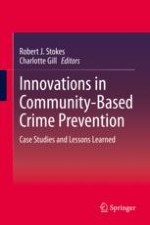
2020 | OriginalPaper | Chapter
1. In Support of Innovative Partnerships for Crime Prevention: The Byrne Criminal Justice Innovation Program
Authors : Robert J. Stokes, Charlotte Gill
Published in: Innovations in Community-Based Crime Prevention
Publisher: Springer International Publishing
Activate our intelligent search to find suitable subject content or patents.
Select sections of text to find matching patents with Artificial Intelligence. powered by
Select sections of text to find additional relevant content using AI-assisted search. powered by